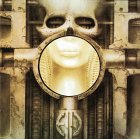|
|


TechnoFILE is copyright and a registered trademark © ® of
Pandemonium Productions.
All rights reserved.
E-mail us Here!

Ear Candy from Brain Saladby Jim Bray I’ve just had my socks knocked off by a new audio format. It’s DVD Audio and, though there aren’t a lot of titles available yet, the one example I’ve heard was amazing – and I didn’t even play it on the proper equipment! The Audio Epiphany came from of Rhino’s DVD Audio release of the classic Emerson, Lake and Palmer album “Brain Salad Surgery.” I’ve always loved that record, but the CD’s sound muddy. This version, however, is spectacular. Despite the album’s nearly thirty year age, it sounds better than some of today’s state-of-the-art recordings. I first heard DVD Audio at the Consumer Electronics Show a few years back and, while the demo sounded impressive, I never believe something’s for real until I experience it under real world conditions. Now I have and, as you may have noticed, I gibber with delight. DVD Audio is made possible by the huge amount of storage available on a DVD. That extra elbow room for data allows for more bits and higher “sampling rates” which, in a nutshell, means the size and number of "digital pictures of the music" the recorder takes each second. Rather than using the CD’s 16 bits sampled at 44.1 kHz, DVD Audio uses 24 bits sampled at up to 192 kHz. The really high sampling is referred to as MLP (Meridian Lossless Packing) Recording, and it reconstructs the original recording bit by bit. MLP recording can only hold stereo information at the moment, but “less highfalutin’” DVD Audio discs can offer real multi-channel surround sound. The result, at least on “Brain Salad Surgery,” is sound that’s incredibly lifelike, highly defined, clean and, best of all, REALLY LOUD! Audiologists are sure to love the extra business… Then there’s the 5.1 channel DVD Audio remix, which offers a whole new musical experience for those who never experienced quadraphonic sound back in the 1970’s. I loved quad, but it never sounded as good as this. That’s partly because the Dolby 5.1mix, being all digital, gives much better separation between the different channels (front left, center and right, surround left and right, and subwoofer). This means ELP’s wild, studio-created special effects – like music swirling around you from speaker to speaker and synthesizers that jump all over the place– comes through loud and clear, immersing you in the experience. That’s only one aspect of the surround sound, though. While I haven’t listened to one yet, I imagine that a properly recorded and mixed DVD Audio version of a live album will make you feel as if you’re really at the show! Remember, when you’re at a concert you don’t only hear the music that’s being played, you also hear its reflections from walls, trees, fat people, or whatever else happens to be around. This is something audio manufacturers have tried to fudge digitally with simulated "concert hall-type" settings on their receivers/processors, with varying degrees of success. There’s a caveat to this audio ecstasy, though. To get the entire benefit of DVD Audio, you need a DVD player and audio system that are up to the task (you should be able to tell by the DVD Audio logo on the equipment). The format requires a DVD player with six-channel analog outputs and your receiver/preamp, naturally, will need corresponding inputs. DVD audio players are expected to cost around $900. I haven’t had a chance to try the real McCoy yet, so my marvelous “Brain Salad Surgery” experience was achieved using a conventional DVD player. I can’t imagine how much better it could sound, but I’m willing to try… As with DVD movies, “Brain Salad Surgery” also includes some extras, like videos, lyrics, and a photo gallery, though you can’t access them on all DVD players. Fortunately, the bonus material is merely icing on an already delicious cake. Unfortunately, the DVD Audio format has a competitor for your hard-earned after-tax dollars. Sony/Philips' Super Audio CD is a hybrid disc that contains the normal data layer of a Compact Disc, enhanced with a second, high density layer. This extra tier of data is where they store the "ultra high quality" multi-channel sound, text and graphics. I haven’t heard an SACD disc, so can’t say how good it is, but it’s probably excellent. I hope it doesn’t mean we’re facing another VHS/beta standards war. That’s the last thing consumers need. Jim Bray's technology columns are distributed by the TechnoFILE Syndicate. Copyright Jim Bray.
|
|
|
|
|
| Support TechnoFile via Paypal |
| TechnoFILE's
E-letter We're pleased to offer our FREE private, subscription-based private E-mail service. It's the "no brainer" way to keep informed. Our Privacy Policy |